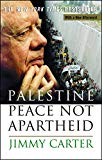
One of Jimmy Carter’s lifelong goals has been to find a way to create a peaceful solution to the conflict between Israel and Palestine. Carter has traveled extensively throughout the Middle East, spoken with political leaders and ordinary citizens, and studied the underlying issues and concerns of Israel, Palestine,and the other Arab nations that neighbor both countries. In Palestine Peace Not Apartheid , Carter explores the history of this volatile conflict, explains past attempts at peace, and suggests measures that need to be taken in order for any peace plan to succeed.
Carter’s first trip to Israel was at the invitation of Yitzhak Rabin during his term as Governor of Georgia. After his first visit, Carter thought that Israel should leave the territories they occupied at the time in the interest of peace. As Carter became more involved with the key players in the conflict, he began to see that the solution to the conflict is much more complicated than simply turning over land.
Throughout the years, many attempts have been made to negotiate an agreement between Israeli leaders and the Palestinians. One of the most notable attempts was one spearheaded by Carter during his presidency. Carter brought Menachem Begin and Anwar Sadat together at Camp David for a twelve day summit. Carter worked with both leaders in order to create the Camp David Accords. However, these Accords are violated and abandoned a few years later.
The presence of the Palestinian Liberation Organization (PLO) has also complicated matters. Many of the actions taken by this organization have been seen as terrorist acts by Israel and other countries worldwide. These acts have continued because the people committing these acts are seen as martyrs and glorified by the Palestinian people. Because of this, the actions have continued, and at some points, intensified.
A recent threat to the peace process is the existence of a wall encircling the Palestinian people, segregating the Palestinians from the Israelis. Many world leaders see the existence of this wall as a form of apartheid, and the United Nations has called the existence of this wall unlawful. One of the main reasons the wall has been constructed is because it allows Israel to claim land that had been previously held by Palestine. The United Nations has demanded that the wall be removed and that Israel should compensate the Palestinians that have been negatively impacted by the construction of the wall. Carter believes that no steps toward peace can be made until this wall has been removed.
Carter’s book does an excellent job explaining a very complicated and controversial history. Carter provides a timeline in the beginning of the book to help readers understand the significance and impact of past events. He also describes the conditions that must be met in order to create a successful, long-term peace plan.
Carter’s unique position allows the reader a different perspective than other books on the topic. Palestine: Peace Not Apartheid presents the history of the conflict between Israel and Palestine from the perspective of a leader who continues to work in order to reach an acceptable middle ground.
Already have an account? Log In Now